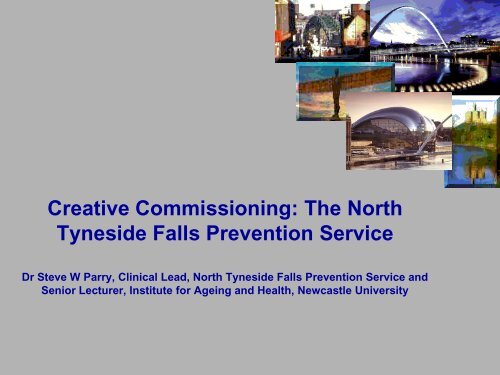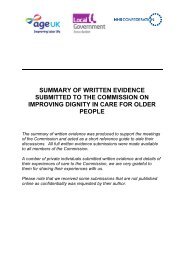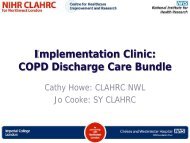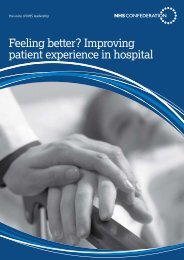Steve Parry
Steve Parry
Steve Parry
Create successful ePaper yourself
Turn your PDF publications into a flip-book with our unique Google optimized e-Paper software.
Creative Commissioning: The North<br />
Tyneside Falls Prevention Service<br />
Dr <strong>Steve</strong> W <strong>Parry</strong>, Clinical Lead, North Tyneside Falls Prevention Service and<br />
Senior Lecturer, Institute for Ageing and Health, Newcastle University
The North Tyneside Falls Prevention<br />
Service<br />
• Multi-agency falls prevention service<br />
• Local gaps in service provision<br />
• Idea to fill the gap<br />
– Enhance case finding<br />
– Preventive service provision<br />
• Involvement of key stakeholders to further the vision<br />
• Commissioning perspective and involvement<br />
• Service delivery, evaluation and justification
• Falls and blackouts<br />
Overview<br />
– Common and overlapping<br />
• 35-60% of over 65 years<br />
– A Fib 1%; Heart failure 5%<br />
• 10% suffer fractures<br />
– Expensive<br />
• >£4 billion per annum<br />
– Devastating<br />
• Personal, carer, health economic effects
NICE guidance on falls 2004<br />
“ All health professionals coming into contact with older<br />
patients should ask whether they have fallen in the last year”<br />
“Refer for specialist assessment if 2 or more falls”<br />
Chapter 8 CHD NSF Quality<br />
Requirements:<br />
“Service improvements locally via…improving access to<br />
a higher level of expertise by the development of<br />
multi-disciplinary arrhythmia and/or blackout clinics”<br />
“People presenting with arrhythmias, in both emergency<br />
and elective settings, receive timely assessment by<br />
an appropriate clinician to ensure accurate diagnosis<br />
and and effective treatment and rehabilitation”
The North Tyneside context…..<br />
• 192,000 patients<br />
– 44,160 >60 years<br />
– 15,900 >75 years<br />
• Lower prevalence estimate of 35%<br />
– 15,500 fallers<br />
• Approx 1500 seen by existing services<br />
• Seen late in falls and blackouts “career”<br />
– (14,000 not being seen at all)<br />
• >60 years to rise from 23% to 32% in next decade<br />
• Good evidence base to show that MDT approach is<br />
both clinically and health economically effective
• Get your facts straight<br />
Tip #1<br />
– Help your commissioners to “see the light”<br />
– Show why your service is needed within the local<br />
context<br />
– Don’t shroud wave<br />
– Don’t over-egg the pudding; present the facts<br />
without spin – its always obvious<br />
– Understand that your commissioning team also<br />
want to promote good healthcare<br />
– Make extrapolations explicit and sensible<br />
– Cost savings estimates rarely do as they say they<br />
will – be realistic
Tip #2<br />
• Get the right team around the table BEFORE you<br />
tackle commissioning issues<br />
– Newcastle Hospitals Foundation Trust<br />
– Private primary care provider (Norprime)<br />
– Age UK<br />
– Newcastle University<br />
– North of Tyne PCT<br />
– North Tyneside Social Services<br />
– North East Ambulance Service
Targeted specialist falls and blackouts<br />
assessment in community setting<br />
• Senior physiotherapy assessment and treatment<br />
• HCA review<br />
• ECG, lying and standing blood pressure<br />
• Depression scale, MMSE, falls and balance confidence scale,<br />
visual acuity<br />
• Medical assessment<br />
• History, examination, bone health risk assessment<br />
• Review of findings, education, counselling<br />
• Recommendations to primary care<br />
• Referrals to 2ry care, Age UK strength and balance<br />
training classes, social services<br />
• Individualised care plan
Tip #3<br />
• Ensure service users are represented in the<br />
development of your service plan<br />
• Ensure appropriate partnership in terms of service<br />
provision<br />
– Age UK key partner<br />
– Service design and development<br />
– Novel service provision using existing<br />
infrastructure and organisation<br />
• Targeted strength and balance training classes
Tip #4<br />
• Destructive innovation and serendipitous planning<br />
• Aka pick your moment and don’t be afraid to escalate<br />
given the opportunity<br />
– Partnerships in place<br />
– Service model developed<br />
– Commissioning team interested and going through<br />
usual channels<br />
– Opportunity to present to PCT Executive<br />
• Rapid escalation to service provision
What can be accomplished:<br />
The first 2 years.....New diagnoses<br />
• 2554 patients seen in the first 2 years of operation<br />
• 985 (40%) ADDITIONAL DIAGNOSES<br />
– Diagnoses making a difference to falls and syncope<br />
risks or relevant to national guidance and targets (eg<br />
early identification of cognitive impairment)<br />
– NOT existing diagnosis<br />
• 986 (39%) gait and balance abnormalities<br />
– All given home exercises<br />
– Additional physio advice, day hospital, community<br />
physio<br />
– 25% referred for Age UK strength and balance training<br />
classes
Others of note......<br />
Atrial fibrillation 26<br />
Stroke, cerebellar syndrome 16<br />
New murmurs 43<br />
Benign positional paroxysmal vertigo 70<br />
Orthostatic hypotension 92<br />
Permanent pacemaker referral 17<br />
Further 35 with significant, possibly culpable brady 35<br />
Parkinsonism, newly diagnosed 8<br />
Vasovagal syncope 75<br />
Significant depression per GDS score 73<br />
Significant cognitive impairment per MMSE
• Osteoporosis<br />
– All undergo FRAX<br />
The first two years....<br />
– 31 high risk “recommend treatment”<br />
– 145/1560 (9.1%) referred for DEXA, 1/3 treated<br />
• 693 with falls efficacy scale score >23<br />
• Ongoing £840k NIHR HTA funded RCT of cognitive<br />
behavioural therapy for this patients<br />
• Independent data from DH evaluation of patient<br />
satisfaction (3.8/4 overall)
The first 2 years....referral patterns<br />
• 25% to Age UK for strength and balance training<br />
classes – part of pathway rather than “referral”<br />
• 25% suggest see GP for meds modification, review of<br />
new Afib, cognitive impairment, depression etc<br />
• 10.5% referred for secondary care review<br />
– Cardiology, falls and syncope, day hospital, ENT
Tip #5<br />
• Ongoing service evaluation and reporting to those<br />
commissioning<br />
– Make your evaluation relevant to the local health<br />
economy<br />
– Refer to local, regional and national priorities and<br />
guidelines<br />
– Without this, you are doomed……
•No changes to services<br />
apart from N Tyne Falls<br />
Prevention Service<br />
•North Tyneside population<br />
over 60:<br />
•40,572<br />
•Newcastle population over<br />
60<br />
•46,670<br />
Difference in 2010-11<br />
of 51 hip fractures<br />
Average tariff of<br />
£10,000<br />
£510,000 saved<br />
Note 30% mortality<br />
rate<br />
25% res/NH care<br />
330<br />
320<br />
310<br />
300<br />
290<br />
280<br />
270<br />
260<br />
250<br />
Fracture Neck of Femur<br />
2008-09 2009-10 2010-11<br />
North Tyneside Newcastle
NOF %<br />
15<br />
10<br />
5<br />
0<br />
-5<br />
-10<br />
Year on year change in FNOF rates<br />
2009-10 2010-11<br />
Newcastle 3.21 11.42<br />
North Tyneside -6.27 2.46
Non-elective admissions: N Tyne Falls Prevention Service<br />
Patients versus Cramlington Control Group<br />
Rate free from fall related hospital ad<br />
0.90 0.92 0.94 0.96 0.98 1.00<br />
Control group<br />
Intervention group<br />
420 day Kaplan-Meier surv<br />
0 100 200 300 400<br />
Days
Non-elective admissions: N Tyne Falls Prevention<br />
Service Patients versus Cramlington Control Group<br />
• N Tyne Falls Prevention Service<br />
– 741 non-elective admissions per 10,000 population<br />
• Cramlington Control Practice<br />
– 768 non-elective admissions per 10,000 population<br />
– 27 non-elective admissions saved @ £5,000 ie<br />
£135,000<br />
• For North Tyneside with 40,000 >65s: £540,000<br />
• For whole of NoT with 160,000 >65s: £2,160,000<br />
• 50% reduction in mortality for those seen by Service v<br />
not seen after A&E admission p=0.0000007
So...getting your service commissioned…an<br />
approach….<br />
• Evidence-based approach based on national and<br />
international guidance and best practice<br />
• Informed by local and regional priorities<br />
• Partnership approach<br />
• Multi-agency, multidisciplinary<br />
• Coherent case, with qualitative, quantitative and<br />
health economic dimensions<br />
• Measurable, reportable, sustainable in the longer<br />
term<br />
• Importance of third sector and other partners in<br />
informing service design and providing service<br />
delivery
…and what can be achieved….<br />
• Service that all partners can take credit for<br />
• Clear benefits to patients previously not seen by<br />
services<br />
– Significant additional diagnoses with further quality<br />
and cost implications<br />
– Case finding for atrial fibrillation, osteoporosis,<br />
dementia, depression, recurrent syncope<br />
– 25% strength and balance training classes with<br />
enormous benefits<br />
– Less tangible public health dimension<br />
• Smoking, weight loss, alcohol intake, exercise
…and what can be achieved….<br />
• Clear early evidence of reduction in fall related<br />
hospital admissions<br />
• Clear early evidence of reduction in hip fracture<br />
• Further data awaited (other fragility fractures,<br />
syncope, A&E data)<br />
• Tangible initial cost savings conservatively estimated<br />
at £645,000 (annual cost to PCT £280k)
• Pilot versus permanent<br />
Problems and pitfalls<br />
– Runner up in BMJ Innovation Awards<br />
– DH Integrated Care pilot winner<br />
– Superb results, 3600 seen in 3 years<br />
– Still not permanently commissioned<br />
• A little too novel, commissioning climate state<br />
of flux, pilot schemes more common<br />
• Destructive innovation and serendipitous planning<br />
– Private primary care provider<br />
– Deep dislike from some of “usual route” team<br />
– Keep all onside
Hazel’s tale....post Age UK classes<br />
“I don’t use the walking sticks at all in the house now,<br />
and use them much less outside as well. It’s easier<br />
to get in the shower above the bath, and up and<br />
down the back step. Because I’m not holding the<br />
sticks any more I can reach things, cook and clean<br />
more easily – it’s great to be able to do these myself .<br />
I’m also finding it easier to use public transport again,<br />
instead of always needing to get a taxi.”





